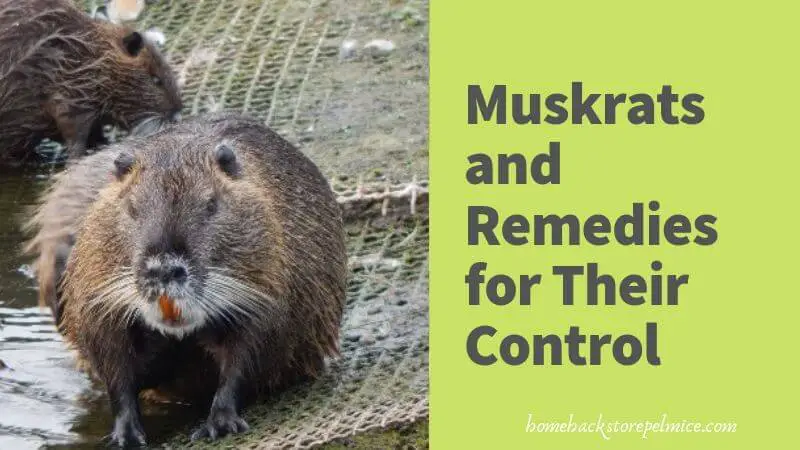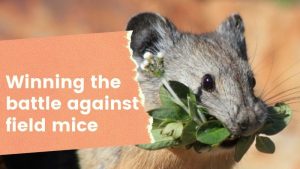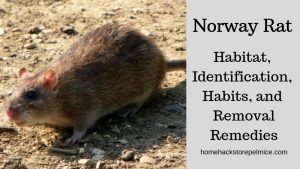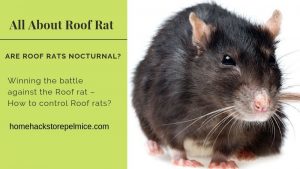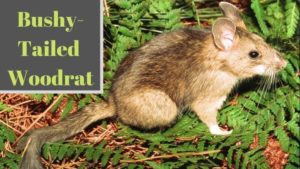The muskrat has the Binomial scientific name Ondatra zibethicus. Though muskrats are also known as common muskrat, water rat or rat, they are not actually the members of the genus Rattus. The muskrat actually belongs to the subfamily Arvicolinae.
This rat gets its name because it looks like a rat and due to the musky odor that is produced by its scent glands. Muskrats are mammals.
How do I identify Muskrats?
The muskrat is a large rodent and grows to about one to two feet long. It has a burly body, a round shaped head, and two musk glands under its tail. It has a long, coarse black colored tail that measures about 7 to 12 inches long. Its tail is vertically flattened and it works like a rudder to help it swim in the water!
This rat has dense, soft, and shiny fur. It is reddish-brown to dark brown in color with a pale underbelly. Under the guard fur, it has a waterproof fur coat. Its thick fur not only traps air to keep them warm but also helps them to float in water. It has small front legs and larger rear feet. Muskrat feet are partially webbed.
How to differentiate between a Muskrat, American Beaver, and a Nutria?
The muskrat looks quite similar to the American Beaver and Nutria due to their similar appearance and common habitat. It can be differentiated from the American beaver and nutria using these signs:
- Tail: The muskrat tail is vertically flattened while the Nutria’s tail is round in shape. The tail of the muskrat is smaller than the beaver.
- Size: The muskrat size is much less compared to the beaver. It is also smaller than the nutria.
- Teeth: It does not have large incisor teeth like the beaver and nutria.
The lifespan of Muskrat & Reproduction:
Muskrats live about three to four years in the wild and may live up to ten years in captivity.
The female may breed during the first year of its birth and gives birth to about five litters every year. The size of every litter may vary from two to nine young ones. These rats are prolific breeders and have a really high reproduction rate. The average gestation period lasts approximately 28 to 30 days. Muskrat mating season usually begins in spring.
Habitat—where do Muskrat live?
These rats can live near both freshwater and saltwater bodies. They are usually found living in marshland, swamps, marshes, drainage ditches, pits, roadside ditches, and water bodies like beaver ponds, ponds, streams, lakes, rivers, dams, and canals. It chooses a habitat with about five to six feet of motionless or slow-moving water. It also prefers plants like sedges, cattails, bulrushes, and pondweeds in its vicinity.
In shallow water areas, muskrats live in shelters with a typical conical shape using different types of plant materials. A muskrat house has numerous underwater entrances via “runs” or trails. They may also have feeding stations, or platforms, that are smaller than their houses or dens.
In marshy surroundings, the muskrat den is usually a dome-shaped shelter or lodge made of plants. Such a lodge is usually about five feet across and four feet high in size. The muskrat burrow has a tunnel and a nesting chamber with an underwater entrance.
Food Habits – What does Muskrat like to eat?
Muskrats eat a largely herbivorous diet and are often called “dainty feeders“. Its food consists of a wide variety of aquatic plants like pickerelweed, smartweed, cattail, horsetail, bulrush, waterlily, duck potato, and, sedges. They feed on bulbs, tubers, plant shoots, leaves, and stems of aquatic plants. They especially prefer carrots, alfalfa, apples, corn, and clover. They also feed on rice grown in flooded water.
Occasionally, they may eat aquatic animal matter such as turtles, fish, frogs, mussels, and clams. They may also feed on snails, crustaceans, and even small birds. Muskrats need to eat food that is approximately one-third of their weight every day.
Predators of muskrat:
Some of the known predators of muskrat are raccoons, otters, minks, coyotes, owls, harriers, and alligators. Sometime young ones may also be killed by adult muskrats.
Muskrat Behavior Habits – Are they aggressive?
The muskrat is usually nocturnal. They are generally active at twilight.
On some occasions, they can be quite aggressive and may attack dogs or mink, if threatened. Muskrats may even attack humans under extreme conditions.
They are monogamous breeders. They live with their mates and young ones. During the cold winter months, muskrats often hibernate in their lodges.
These rats are great swimmers due to their flattened tail and partly webbed hind feet. Muskrat swimming speeds are approximately 3 miles per hour. During feeding sessions, it can even swim backward and can stay beneath the water for about 20 minutes. Though they are excellent swimmers, they are not very fast movers on land.
Signs of Muskrat infestation
Some of the signs that indicate an infestation are:
- Tracks: Muskrat tracks have four toes in front and five in the back. The tracks also show visible claws and tail marks.
- Droppings: Their droppings are usually found on dry and higher surfaces like rocks, feeding platforms, logs, and wood stumps.
- Lodges: They build lodges using aquatic plants and mud.
- Burrow entrance: Their burrows have entrances that are about 6-8″ in diameter.
- Leaking ponds: Their burrowing may lead to leaking dams, ponds, and even collapsed banks.
- Gnaw Markings: They gnaw markings are usually found on trees near water bodies, and partially eaten aquatic plants like sedges and water lilies.
- Mussel remains: Caches of mussel shells can be found on vegetation rafts or near feeding platforms indicate infestation.
Damage Caused by the Muskrat:
They cause widespread damage to vegetation and property located near its aquatic habitat. Muskrat damage may lead to severe economic losses as well.
- Pond drainage and leakage: They burrow into the banks of farm ponds, reservoirs, check dams, dikes, and dams. This leads to leakages and pond drainage.
- Damage to vegetation: These rats are herbivores by nature. They cause damage to vegetable patches and other forms of vegetation.
- Destruction of crops: They eat on grain crops, mainly rice, and destroy the agricultural crop.
- The loss to human property: They gnaw on structures such as boating docks, floating devices, and platforms causing severe damage to them.
- Eat out Damage: A muskrat population increase causes “Eat-outs”. “Eat-outs” are areas where vegetation has been completely removed due to muskrat activities and may take several years to recover.
The threat to Humans:
Muskrats are often dangerous for humans as well. If they feel threatened or cornered, they may become aggressive and attack human beings, especially children. If you are staying in the vicinity of a water body, you should look out for these rats as they can be a potential danger to kids playing outside.
Hazards of the Muskrat in the house—do Muskrat spread diseases?
Like all rodents, muskrats are carriers to infectious diseases and may transmit them to humans. Muskrat diseases include:
- Tularemia: Humans can also contract tularemia, a bacterial disease by touching an infected open wound on the animal. It can be life-threatening so protective gloves should be worn when handling muskrats.
- Leptospirosis: They also carry leptospirosis Often, drinking water may be contaminated with leptospirosis bacteria leading to transmission to humans. If left untreated it may lead to Weil’s disease. It may cause ailments like meningitis, kidney or liver damage, breathing problems, and on rare occasions even death.
- Giardiasis: These rats are carriers of giardiasis organisms. It is transmitted to humans through drinking water which is contaminated with muskrat fecal matter.
- Rabies: They also carry the rabies virus, which may be transmitted to pets and humans if they are bitten by muskrats.
Managing muskrat menace – how to get rid of muskrats:
Muskrats menace can be controlled with several preventive measures: Here are some methods that help you get rid of muskrats:
- Plant your crops or garden at a distance of more than 200-yard away from the muskrat range.
- Use fencing or protective enclosures to keep the muskrats away from food sources.
- Gentle slopes on shorelines will deter the muskrats more than steep slopes.
- Use stone barriers to control muskrat entry.
How to trap muskrats:
Here are traps that are suitable for muskrats:
- Leghold type trap: The most commonly used and traps for trapping muskrats are the leghold type traps. It is the most preferred choice because it is very effective even in deep water. As it kills the muskrat almost instantly, it eliminates any chance of escapes. The trap should be placed strategically in its usual track near the entrance of the burrow.
- Stovepipe trap: It is very useful for farm ponds, marshes, and rice fields. It has the capacity to make multiple catches, sometimes three to four at a time. It should be set up near a den entrance. It can be made easily at home using stovepipes.
- Other Sets: Culvert sets, polo sets, and under ice sets may also be used to trap muskrats.
Muskrats are a cause of property damage, financial loss as well as carriers of diseases. Taking long term precautions and actions is necessary when dealing with their menace.
